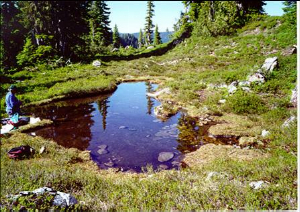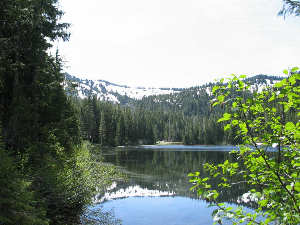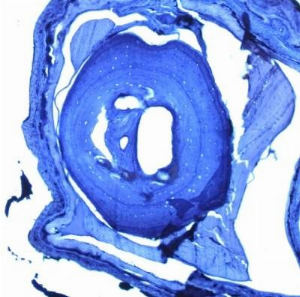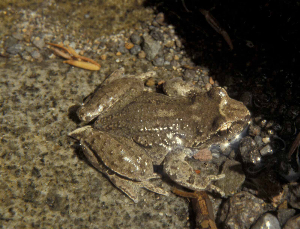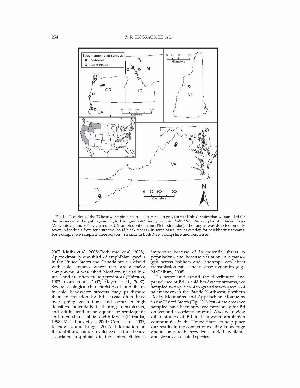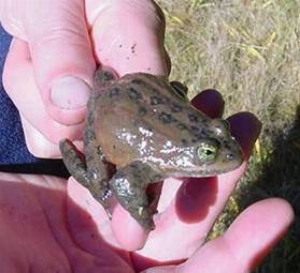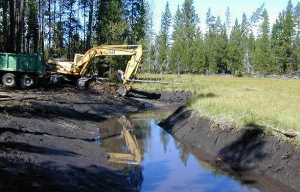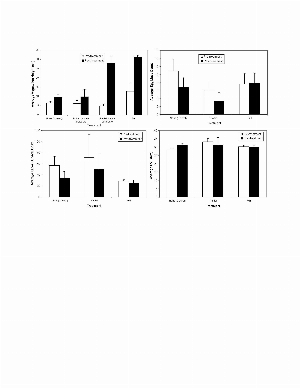Search ARMI Database
Search term(s)
Contribution Number
Search Results
74 record(s) found.
Papers & Reports Rana aurora (Baird and Girard, 1852[b]), Northern red-legged frog
Authors: Christopher A Pearl
Date: 2005 | Outlet: Lannoo M, editor. Amphibian declines: the conservation status of United States species. Berkeley: University of California Press Pp 528-530
Papers & Reports Optical characteristics of natural waters protect amphibians from UV-B in the US Pacific Northwest: reply
Authors: Wendy J Palen; D E Schindler; Michael J Adams; Christopher A Pearl; Richard B Bury; S Diamond
Date: 2004-06-01 | Outlet: Ecology 85: 1754-1759
Few ecologists would dispute that exposure to high levels of ultraviolet-B radiation (UV-B) is detrimental to organisms. It is well established that UV-B has been a critical factor shaping the physiology (Blum et al. 1949, Hansson 2000), behavior (Pennington and Emlet 1986, van de Mortel and Buttemer 1998), and distribution (Williamson et al. 2001, Leavitt et al. 2003) of many aquatic species. Recently, increasing UV-B caused by stratospheric ozone depletion has stimulated much research on the UV-B sensitivity of a wide variety of taxa, and has been found to cause direct mortality (Calkins and Thordardottir 1980, reviewed by Siebeck et al. 1994), elevate developmental abnormalities (Ankley et al. 2002), increase susceptibility to disease (Little and Fabacher 1994, Kiesecker and Blaustein 1995), and change the strength of species interactions (Sommaruga 2003). Increasing levels of UV-B have also been invoked as an explanation for the decline of some amphibian species, and support for this hypothesis has been extrapolated from many laboratory experiments and field studies at individual sites that indicate ambient or enhanced levels of UV-B can increase mortality of embryos and larvae (but see Licht 2003). This has been an especially attractive hypothesis for amphibian populations in alpine environments where direct anthropogenic impacts such as habitat modification are limited and ambient levels of UV-B are high (Blaustein and Wake 1990, Blaustein et al. 1994, Alford and Richards 1999). However, for all the attention UV-B has received in the context of declining amphibian populations, there is little evidence linking the physiological sensitivity of individuals to actual population dynamics (Licht 2003).
Papers & Reports Optical characteristics of natural waters can protect amphibian populations from UV-B in the US Pacific Northwest
Authors: Wendy J Palen; D E Schindler; Michael J Adams; Christopher A Pearl; Richard B Bury; S Diamond
Date: 2002 | Outlet: Ecology 83: 2951-2957
Increased exposure to ultraviolet-B (UV-B) radiation has been proposed as a major environmental stressor leading to global amphibian declines. Prior experimental evidence from the US Pacific Northwest (PNW) has established the embryonic sensitivity of at least 4 amphibian species to UV-B and has been central to the amphibian decline literature. However, these results have not been expanded to address population-scale effects and natural landscape variation in UV-B transparency of water at amphibian breeding sites; necessary links to assess the importance of UV-B for amphibian declines. We quantified the UV-B transparency of 136 potential amphibian breeding sites to establish the pattern of UV-B exposure across two montane regions in the PNW. Our data suggest that 85% of sites are naturally protected by dissolved organic matter (DOM) in pond water, and that only a fraction of breeding sites are likely to experience UV-B intensities exceeding levels associated with elevated egg mortality. Thus, the spectral characteristics of natural waters mediate the physiological effects of UV-B on amphibian eggs in all but the clearest sites. These data imply that UV-B is unlikely to cause broad amphibian declines across the landscape of the American Northwest.
Papers & Reports A Protocol for Aging Anurans Using Skeletochronology
Authors: Brome McCreary; Christopher A Pearl; Michael J Adams
Date: 2008 | Outlet: US Geological Survey Open-File Report 2008-1209
Age distribution information can be an important part of understanding the biology of any population. Age estimates collected from the annual growth rings found in tooth and bone cross sections, often referred to as Lines of Arrested Growth (LAGs), have been used in the study of various animals. In this manual we describe in detail all necessary steps required to obtain estimates of age from anuran bone cross sections via skeletochronological assessment. We include comprehensive descriptions of how to fix and decalcify toe specimens (phalanges), process a phalange prior to embedding, embed the phalange in paraffin, section the phalange using a microtome, stain and mount the cross sections of the phalange and read the LAGs to obtain age estimates.
Papers & Reports Taxonomic variation in oviposition by tailed frogs (Ascaphus spp.)
Authors: N E Karraker; David S Pilliod; Michael J Adams; Evelyn L Bull; P. Stephen Corn; L V Diller; L A Dupuis; Marc P Hayes; Blake R Hossack; G R Hodgson; E J Hyde; K Lohman; B R Norman; Lisa M Ollivier; Christopher A Pearl
Date: 2006 | Outlet: Northwestern Naturalist 87: 87-97
Tailed frogs (Ascaphus spp.) oviposit in cryptic locations in streams of the Pacific Northwest and Rocky Mountains. This aspect of their life history has restricted our understanding of their reproductive ecology. The recent split of A. montanus in the Rocky Mountains from A. truei was based on molecular differentiation, and comparisons of their ecology are limited. Our objectives were to provide a range-wide summary of information on Ascaphus oviposition,compare some aspects of the reproductive ecology of the 2 species, and examine geographic variation in their reproductive traits. Reproductive ecology of the 2 species differed. Ascaphus truei had smaller clutches, oviposited later in the summer, and had a longer duration of oviposition than A. montanus. A greater number of communal oviposition sites were attributed to A. montanus. These ecological differences support the recent taxonomic revision of Ascaphus and suggest that different management strategies may be necessary for each species where conservation is a priority.
Papers & Reports Cannibalism and predation by western toad (Bufo boreas) larvae in Oregon, USA
Authors: D J Jordan; C J Rombough; Christopher A Pearl; Brome McCreary
Date: 2004 | Outlet: Western North American Naturalist 64: 403-405
Papers & Reports Low prevalence of chytrid fungus (Batrachochytrium dendrobatidis) in U. S. headwater amphibians
Authors: Blake R Hossack; Michael J Adams; Evan HC Grant; Christopher A Pearl; Jamie Bettaso; William J Barichivich; W H Lowe; K True; J L Ware; P. Stephen Corn
Date: 2010-06-01 | Outlet: Journal of Herpetology 52: in press
Many declines of amphibian populations have been associated with chytridiomycosis, a disease caused by the aquatic fungus Batrachochytrium dendrobatidis (Bd). Despite the relatively high prevalence of chytridiomycosis in stream amphibians globally, most surveys in North America have focused primarily on wetland-associated species, which are frequently infected. To better understand the distribution and prevalence of Bd in headwater amphibian communities, we sampled 452 tailed frogs (Ascaphus truei and Ascaphus montanus) and 304 stream salamanders (seven species in the Dicamptodontidae and Plethodontidae) for Bd in 38, first- to third-order streams in five montane areas across the United States. We tested for presence of Bd by using PCR on skin swabs from salamanders and metamorphosed tailed frogs or the oral disc of frog larvae. We detected Bd on only seven individuals (0.93%) in four streams. Based on our study and results from five other studies that have sampled headwater- or seep-associated amphibians in the United States, Bd has been detected on only 3% of 1,322 individuals from 21 species. These results differ strongly from surveys in Central America and Australia, where Bd is more prevalent on stream-breeding species, as well as results from wetland-associated anurans in the same regions of the United States that we sampled. Differences in the prevalence of Bd between stream- and wetland-associated amphibians in the United States may be related to species-specific variation in susceptibility to chytridiomycosis or habitat differences.
Papers & Reports Range-wide phylogeographic analysis of the spotted frog complex (Rana luteiventris and R. pretiosa) in northwestern North America
Authors: W C Funk; Christopher A Pearl; H M Draheim; Michael J Adams; T D Mullins; S M Haig
Date: 2008-06-04 | Outlet: Molecular Phylogenetics and Evolution 49: 198-210
The dynamic geological and climatic history of northwestern North America has made it a focal region for phylogeography. We conducted a range-wide phylogeographic analysis of the spotted frog complex (Rana luteiventris and R. pretiosa) across its range in northwestern North America to understand its evolutionary history and the distribution of clades to guide conservation of R. pretiosa and Great Basin R. luteiventris, both candidates for listing under the U.S. Endangered Species Act. Mitochondrial DNA sequence data from a segment of the cytochrome b gene were obtained from 308 R. luteiventris and R. pretiosa from 98 sites. Phylogenetic analysis revealed one main R. pretiosa clade and 3 main R. luteiventris clades, 2 of which overlapped in southeastern Oregon. The 3 R. luteiventris clades were separated from each other by high levels of sequence divergence (average of 4.75–4.97%). Two divergent clades were also uncovered within the Great Basin. Low genetic variation in R. pretiosa and the southeastern Oregon clade of R. luteiventris highlights their vulnerability to extinction.
Papers & Reports Demography and movement in a relocated population of Oregon Spotted Frogs (Rana pretiosa): influence of season and gender
Authors: Nathan D Chelgren; Christopher A Pearl; Michael J Adams; Jay Bowerman
Date: 2008-12-18 | Outlet: Copeia 2008: 742-751
Translocation, repatriation and relocation of wildlife are increasingly considered as methods in the management of imperiled wildlife populations. Yet, few such efforts have been studied in sufficient detail to understand demographic responses within specific life stages. We used five years of recapture data and Bayesian estimation to assess seasonal survival, movement and growth of Oregon Spotted Frogs (Rana pretiosa) relocated into created ponds at Dilman Meadow in Oregon, USA. We evaluate hypotheses specific to the relocation and elucidate aspects of R. pretiosa life history that are poorly known. The odds of survival of relocated individuals during the first year following relocation were https://0.36 times the survival odds of relocated and non-relocated frogs after one year since the relocation. Survival rate was higher for large frogs. After accounting for frog size, we found little variation in survival between ponds at Dilman Meadow. Survival was lowest for males during the breeding/post-breeding redistribution period, suggesting a high cost of breeding for males. The highest survival rates occurred during winter for both genders, and one small spring was used heavily during winter but was used rarely during the rest of the year. Individual growth was higher in ponds that were not used for breeding, and increased with increasing pond age. Our study supports other evidence that R. pretiosa use different habitats seasonally and are specific in their overwintering habitat requirements. Because frogs were concentrated during winter, predator-free overwintering springs are likely to be of particular value for R. pretiosa populations.
Papers & Reports The short-term effect of cattle exclosures on Columbia Spotted Frog (Rana luteiventris) populations and habitat in Northeastern Oregon, USA
Authors: Michael J Adams; Christopher A Pearl; Brome McCreary; Stephanie K Galvan; S J Wessell; W H Wente; Chauncey W Anderson; A B Kuehl
Date: 2009-03-01 | Outlet: Journal of Herpetology 43: 132-138
Livestock grazing is a common land use across the western USA, but concerns have been raised regarding its potential to affect amphibian populations. We studied the short-term effects of full and partial livestock grazing exclosures on Rana luteiventris (Columbia Spotted Frog) populations using a controlled manipulative field experiment with pre- and post-treatment data (2002-2006). Despite a significant increase in vegetation height within grazing exclosures, we did not find treatment effects for egg mass counts, larval survival, or size at metamorphosis 2-3 years following grazing exclosure installation. Water samples taken in late summer showed concentrations of nitrite, nitrate, ammonia and orthophosphate that were low or near detection limits across all ponds and years. The results of this experiment do not support a hypothesis that limiting cattle access to breeding ponds will help conserve R. luteiventris populations in our study area. Further research is needed to evaluate regional variation and long-term effects of grazing exclosures on R. luteiventris populations.
Papers & Reports Indirect facilitation of an anuran invasion by non-native fishes
Authors: Michael J Adams; Christopher A Pearl; Richard B Bury
Date: 2003-03-13 | Outlet: Ecology Letters 6: 343-351
Positive interactions among non-native species could greatly exacerbate the problem of invasions, but are poorly studied and our knowledge of their occurrence is mostly limited to plant-pollinator and dispersal interactions. We found that invasion of bullfrogs is facilitated by the presence of coevolved non-native fish, which increase tadpole survival by reducing predatory macroinvertebrate densities. Native dragonfly nymphs in Oregon, USA caused zero survival of bullfrog tadpoles in a replicated field experiment unless a non-native sunfish was present to reduce dragonfly density. This pattern was also evident in pond surveys where the best predictors of bullfrog abundance were the presence of non-native fish and bathymetry. This is the first experimental evidence of facilitation between two non-native vertebrates and supports the invasional meltdown hypothesis. Such positive interactions among non-native species have the potential to disrupt ecosystems by amplifying invasions, and our study shows they can occur via indirect mechanisms.
Papers & Reports Problems and opportunities managing invasive Bullfrogs: is there any hope?
Authors: Michael J Adams; Christopher A Pearl
Date: 2007 | Outlet: Gherardi F, editor. Biological invaders in inland waters: Profiles, distribution, and threats. Springer, Dordrecht, The Netherlands.
The American Bullfrog (Rana catesbeiana Shaw) is a widely introduced and invasive anuran that is frequently blamed for population declines of native species (Bury and Whelan 1984). Once established, Bullfrog populations are often either difficult or impossible to eradicate depending on habitat and landscape features (Schwalbe and Rosen 1988, Doubledee et al. 2003, Govindarajulu et al. 2005). Bullfrogs are representative of a large but neglected suite of invasive species that are characterized by: 1) a broad invasion that is well established in some areas; 2) a lack of obvious economic impacts compared to some other invasive species; and 3) a lack of reasonably feasible control methods. Despite demonstrated conservation concerns, invasive species like the Bullfrog do not tend to attract the resources necessary to attempt large scale management because of their lack of economic impact and the difficulty of control methods. This leaves biologists responsible for managing habitats invaded by such species with little hope and few options for promoting the persistence of sensitive native species. With these issues in mind, we consider the case of the Bullfrog, review management options, and suggest directions for future research with this and similar species.
Papers & Reports Tailed frog, Ascaphus truei
Authors: Michael J Adams; Christopher A Pearl
Date: 2005 | Outlet: Lannoo M, editor. Amphibian declines: the conservation status of United States species. Berkeley: University of California Press Pp 382-384
A species account for the Tailed Frog (Ascaphus truei[/])
Papers & Reports Using occupancy models to understand the distribution and prevalence of an amphibian pathogen, Batrachochytrium dendrobatidis
Authors: Michael J Adams; Nathan D Chelgren; David Reinitz; R A Cole; L J Rachowicz; Stephanie K Galvan; Brome McCreary; Christopher A Pearl; Larissa L Bailey; Jamie Bettaso; Evelyn L Bull; M Leu
Date: 2010-01 | Outlet: Ecological Applications 20: 289-302
Batrachochytrium dendrobatidis is a fungal pathogen that is receiving attention around the world for its role in amphibian declines. Study of its occurrence patterns is hampered by false negatives: the failure to detect the pathogen when it is present. Occupancy models are a useful but currently underutilized tool for analyzing detection data when the probability of detecting a species is less than 1. We use occupancy models to evaluate hypotheses concerning the occurrence and prevalence of B. dendrobatidis and discuss how this application differs from a conventional occupancy approach. We found that the probability of detecting the pathogen, conditional on presence of the pathogen in the anuran population, was related to amphibian development stage, day of the year, elevation, and human activities. B. dendrobatidis was found throughout our study area but was only estimated to occur in 53.4% of 78 populations of native amphibians and 66.4% of 40 populations of non-native R. catesbeiana tested. We found little evidence to support any spatial hypotheses concerning the probability that the pathogen occurs in a population, but did find evidence of some taxonomic variation. We discuss the interpretation of occupancy model parameters, when, unlike a conventional occupancy application, the number of potential samples or observations is finite

